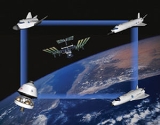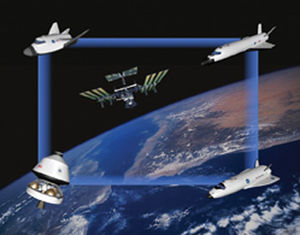
Orbital Space Plane
Encyclopedia

NASA
The National Aeronautics and Space Administration is the agency of the United States government that is responsible for the nation's civilian space program and for aeronautics and aerospace research...
concept designed to support the International Space Station
International Space Station
The International Space Station is a habitable, artificial satellite in low Earth orbit. The ISS follows the Salyut, Almaz, Cosmos, Skylab, and Mir space stations, as the 11th space station launched, not including the Genesis I and II prototypes...
requirements for crew rescue, crew transport and contingency cargo such as supplies, food and other needed equipment. No operable spacecraft was ever built.
With the initiation of the Constellation program in 2004, NASA transferred the knowledge gained on the OSP to the development of Crew Exploration Vehicle
Crew Exploration Vehicle
The Crew Exploration Vehicle was the conceptual component of the U.S. NASA Vision for Space Exploration that later became known as the Orion spacecraft...
, an Apollo-style capsule with separate crew and service module
Service module
A service module is a spacecraft compartment containing a variety of support systems used for spacecraft operations. Usually located in the uninhabited area of the spacecraft, the service module is jettisoned upon the completion of the mission, and usually burns up during atmospheric reentry...
s.
Origin
The initial plans for the International Space StationInternational Space Station
The International Space Station is a habitable, artificial satellite in low Earth orbit. The ISS follows the Salyut, Almaz, Cosmos, Skylab, and Mir space stations, as the 11th space station launched, not including the Genesis I and II prototypes...
envisaged a small, low-cost 'Assured Crew Return Vehicle' (ACRV) which would provide emergency evacuation capability; the X-38 was the prototype of this. Following cancellation of the ACRV in 2002, the program led to the more capable Orbital Space Plane concept.
The first variant of the Orbital Space Plane was designed to serve as a crew rescue vehicle for the ISS; this replaced the previous plans for a dedicated station Crew Return Vehicle
Crew Return Vehicle
The Crew Return Vehicle , sometimes referred to as the Assured Crew Return Vehicle , is the proposed lifeboat or escape module for the International Space Station...
, which had been sidelined by budget cuts.
This early version of the plane had been expected to enter service by 2010.
Function
Future versions of the Orbital Space Plane would have been launched on an existing EELVEELV
Evolved Expendable Launch Vehicle is an expendable launch system program of the United States Air Force , intended to assure access to space for Department of Defense and other United States government payloads...
rocket to carry crews to the International Space Station
International Space Station
The International Space Station is a habitable, artificial satellite in low Earth orbit. The ISS follows the Salyut, Almaz, Cosmos, Skylab, and Mir space stations, as the 11th space station launched, not including the Genesis I and II prototypes...
. It was envisaged that the OSP would operate alongside the Space Shuttle
Space Shuttle
The Space Shuttle was a manned orbital rocket and spacecraft system operated by NASA on 135 missions from 1981 to 2011. The system combined rocket launch, orbital spacecraft, and re-entry spaceplane with modular add-ons...
with the OSP responsible for crew flights and the shuttle handling construction and cargo flights. At the time, the shuttle program was not yet set for retirement and was thought to be technically viable up until the 2030s. Thus it was expected that the two spacecraft would complement each other throughout the lifespan of the ISS. One advantage of this approach would have been assured manned access to space; the lack of this capability was to be highlighted starkly with the loss of Space Shuttle Columbia
Space Shuttle Columbia
Space Shuttle Columbia was the first spaceworthy Space Shuttle in NASA's orbital fleet. First launched on the STS-1 mission, the first of the Space Shuttle program, it completed 27 missions before being destroyed during re-entry on February 1, 2003 near the end of its 28th, STS-107. All seven crew...
.
Top level requirements for the Orbital Space Plane and its related systems were approved in February 2003. In March 2003, the program began evaluating system operations to ensure the alignment of systems design between the NASA mission and the contractor design.
Transfer to the CEV program
The Crew Exploration VehicleCrew Exploration Vehicle
The Crew Exploration Vehicle was the conceptual component of the U.S. NASA Vision for Space Exploration that later became known as the Orion spacecraft...
program was based on four groups of concepts considered for the physical design of the space plane itself — or the vehicle architecture: a capsule, a lifting body, a sharp body with wings and a blunt body with wings (see image).
After the Columbia accident investigation, the capsule design with a separate escape system was considered the optimal design for crew safety.
Other program components
Other components of the OSP program were the X-37 and the DART.The X-37
Boeing X-37
The Boeing X-37 is an American unmanned vertical-takeoff, horizontal-landing spaceplane. The X-37 is operated by the United States Air Force for orbital spaceflight missions intended to demonstrate reusable space technologies...
vehicle was designed to flight test advancing technologies to reduce the risk of future reusable launch vehicle systems, including the Orbital Space Plane.
The Demonstration for Autonomous Rendezvous Technology
DART (spacecraft)
DART, or Demonstration for Autonomous Rendezvous Technology, is a NASA sponsored project. The goal was to develop and demonstrate an automated navigation and rendezvous capability in a NASA spacecraft. Currently, only the Russian Space Agency, JAXA and ESA have autonomous space craft navigation...
or DART, was another flight demonstrator vehicle designed to test technologies required to locate and rendezvous with other spacecraft. Although Russia
Russia
Russia or , officially known as both Russia and the Russian Federation , is a country in northern Eurasia. It is a federal semi-presidential republic, comprising 83 federal subjects...
has mastered this technology for years, this is the first for NASA
NASA
The National Aeronautics and Space Administration is the agency of the United States government that is responsible for the nation's civilian space program and for aeronautics and aerospace research...
. Using onboard guidance sensors, DART would have performed a series of maneuvers around a retired satellite. However, after a successful launch, unknown problems with the guidance system caused the vehicle to run out of thruster fuel prematurely, ending the mission before all objectives could be carried out.
In 2010, Orbital Sciences Corporation
Orbital Sciences Corporation
Orbital Sciences Corporation is an American company which specializes in the manufacturing and launch of satellites. Its Launch Systems Group is heavily involved with missile defense launch systems...
reused some work done under OSP program contracts for its Prometheus
Prometheus (spacecraft)
Prometheus was a proposed manned vertical-takeoff, horizontal-landing spaceplane concept put forward by Orbital Sciences Corporation in late 2010 as part of the second phase of NASA's Commercial Crew Development program.-Design:...
spacecraft proposal to NASA under phase 2 of the Commercial Crew Development
Commercial Crew Development
Commercial Crew Development is a multiphase space technology development program, funded by the U.S. government, and administered by NASA. The program is intended to stimulate development of privately operated crew vehicles to low Earth orbit. It is run by the Commercial Crew and Cargo Program...
program.

